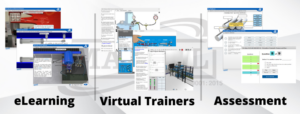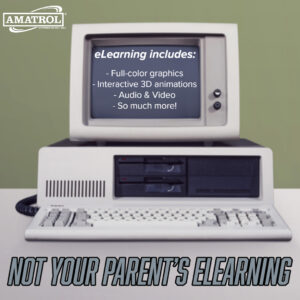To view ‘Switching to eLearning Due to COVID-19? Avoid These Myths About Online Industrial Training’ as a Multimedia presentation, please click here
In its infancy stage, online industrial training was considered an oddity in education. However as years passed, web-based eLearning has become a common learning tool, as schools and training centers worldwide have embraced it thanks to countless advantages associated with it.
But for instructors that have yet to take that leap into eLearning, it can be concerning, or even scary, as several misconceptions still exist including the following:

“It doesn’t go over all that I need it to cover.”
“We already have a book. I’ll just create the online learning section myself.”
“My students aren’t the type to just sit at a computer.”
For some, hesitations behind adopting eLearning curriculum focus around commonly-held misconceptions about the learning solution. Others may start the process, only to learn there are a lot of eLearning providers out there, and it’s difficult to know what is best for your individual program.
However with schools closing across the country due to the COVID-19 outbreak, instructors are now being pushed into using the platform.
While we can’t address other eLearning, we can explain what makes Amatrol’s online learning successful. With more than a decade’s worth of experience creating, developing, and implementing online industrial training, we’re ready to separate fact from fiction when it comes to industrial and advanced manufacturing eLearning, as well as offer some advice on what to look for in an eLearning provider.
Myth #1 – “We have had eLearning before. The curriculum just wasn’t comprehensive enough for us, and didn’t offer the specific courses we needed.”
If you’ve experienced eLearning whose curriculum was lacking, then it definitely wasn’t Amatrol’s.
We’re confident in our curriculum because our learning solutions are designed and built by employees who are experts in their field. From engineers, curriculum developers, programmers, and graphic artists, and even field service technicians, Amatrol’s curriculum goes through an editing gauntlet as it is meticulously combed through by some of the brightest professionals in their line of work.
In fact, what separates Amatrol’s eLearning from the rest of the pack is its attention to detail, especially when dealing with curriculum. That’s why the Amatrol philosophy behind every eLearning course is to engage students and instructors alike in a highly-skilled world where understanding and application integrate seamlessly.
Like an actual instructor’s lesson plan, our eLearning includes objectives, hands-on skills (including Virtual Trainers), and knowledge checks along the way. From defining basic industrial terms to designing a control transformer circuit, for example, Amatrol’s curriculum takes learners on a complete educational journey from beginning to end in a modular format so your program can go as far as you want to take it.
Each lesson focuses on the job-ready skills students need to make a positive impact on the industrial workforce. And don’t worry – there are plenty of reviews and assessments along the way to ensure students are grasping what is being taught in the hundreds of available courses.
Just because you might have experienced poor results in the past, don’t assume that all eLearning is the same.
Advice: If you’re curious about the offerings of an eLearning platform, or whether their curriculum matches up to what you’re teaching, ask for a no-obligation, full-access trial of their complete eLearning library – not just a sample reel they have hand selected. This will allow you the opportunity to take a deep-dive into the entire curriculum, leaving you with a much better understanding of their eLearning products.
Myth #2 – “I’ve taught this course long enough and I can do online industrial training just as well as anyone.”
We do not doubt any instructor’s knowledge level, or their ability to teach their class. What we can offer is an opportunity to expand a course’s depth in a way instructors simply aren’t trained to: by using technology.
Our eLearning is comprised of multiple departments working hand-in-hand to bring the curriculum to life. So while our writers and technicians create the content, our graphic artists and multimedia teams curate it with audio, full-color graphics, interactive 3D animations, and so much more to fully engage learners.
 To replicate the hands-on skills students would receive with full-size training systems, several courses in Amatrol’s online curriculum feature Virtual Trainers. The interactive, computer-based simulators replicate real-life equipment in such stunning detail that students will feel like they are using the actual equipment. Students perform essentially the same industry-based tasks using the virtual equipment that they would perform using equipment hardware.
To replicate the hands-on skills students would receive with full-size training systems, several courses in Amatrol’s online curriculum feature Virtual Trainers. The interactive, computer-based simulators replicate real-life equipment in such stunning detail that students will feel like they are using the actual equipment. Students perform essentially the same industry-based tasks using the virtual equipment that they would perform using equipment hardware.
 Amatrol’s curriculum is also based on multiple subject matter experts, including those from industry and education. This creates a well-rounded curriculum, and is not geared specifically toward one person’s experiences.
Amatrol’s curriculum is also based on multiple subject matter experts, including those from industry and education. This creates a well-rounded curriculum, and is not geared specifically toward one person’s experiences.
So while we know that instructors have the subject and teaching knowledge to create an eLearning course, sometimes the biggest roadblock revolves around lack of time or funds. Many times, we see where instructors start on an eLearning course, but eventually run out of time and resources.
Using our eLearning, we are confident that students can practice sophisticated troubleshooting techniques with confidence that they can translate to the workplace.
Advice: In order to have a truly interactive learning experience for your students, you need programmers and graphic artists to breathe life into the curriculum. So when you’re researching online training companies, be sure to ask about their graphics department, and what type of platform the eLearning is hosted on. If their interactivity isn’t as impressive as their curriculum – or vice versa – then that may not be the company for you.
Myth #3 – “I don’t think my students would even like that style of learning.”
For experienced instructors that come from non-tradition teaching backgrounds, eLearning might be something that was never even considered. Typically, those instructors that come from a background in industry tend to rely on methods they experienced in school, which is usually composed of little-to-no eLearning.

While there is nothing wrong with that style of teaching, it might not be as beneficial for all types of learners. It’s easy to forget that students learn at different paces in a variety of styles, so lecturing might not always be the best way to learn for every student. For example, some students possess a spatial learning style and rely on visual cues to help along the way. Others would rather get more hands-on and take a kinesthetic, or physical, approach to their training.
No matter what style of learner composes a classroom, Amatrol’s eLearning covers all of the bases. For the linguistic (verbal) learners, they can utilize both verbal and written text on every single lesson. There is even something for the logical thinker, including complex calculations and grouped information for easier retention.
Even though learning might be a difficult task for some that enter your training programs, Amatrol’s eLearning takes a variety of approaches to make studying, and especially retention, as simple as possible.
Advice: One of the biggest gripes about online industrial training is that some will equate it to a “click-along” style of learning, which provides no breadth and encourages simply clicking through. Unfortunately, some of that “eLearning” exists. So when considering providers, make sure their online curriculum offers hands-on interactivity. Eventually, students will be able to return to the classroom. Now is a good time to explore whether the eLearning needed now can expand into physical hands-on skills in the future.
Myth #4 – “I’m just so out of touch with computer technology. I wouldn’t know what to do if it stopped working.”
Like it’s preached every day in training centers around the world: If you don’t know a skill, train to learn it! The same can be said about Amatrol’s online industrial training.
 Every year, Amatrol offers free Instructor Training at their headquarters in Jeffersonville, Ind. The training instructors receive is unparalleled, and thousands of teachers have been trained in the program’s 20+ years of existence. Not only will teachers get individualized course implementation consultation from a factory-certified instructor, but they’re ideal for teachers’ professional development and gets them up-to-speed faster by familiarizing them with Amatrol systems and methodologies.
Every year, Amatrol offers free Instructor Training at their headquarters in Jeffersonville, Ind. The training instructors receive is unparalleled, and thousands of teachers have been trained in the program’s 20+ years of existence. Not only will teachers get individualized course implementation consultation from a factory-certified instructor, but they’re ideal for teachers’ professional development and gets them up-to-speed faster by familiarizing them with Amatrol systems and methodologies.
We know that strong curriculum paired with excellent instructors equals skilled students ready for the workforce. So by attending one of Amatrol’s week-long Instructor Training programs, teachers can feel confident in going back to their schools to deliver the very best training possible.
However, despite preparing for everything, issues may arise. If they do, we’ve got you covered with an excellent Support team. Amatrol is committed to exceptional customer service, should you need it – this includes technical support, curriculum inquires, or just general questions.
Advice: This one is easy – simply call up prospective eLearning providers during a normal business day. Try in the morning and afternoon, and see how the experience is. Remember, if an issue does arise, this will be your main form of contact. If you’re having difficulty getting in touch with someone when it’s not an emergency, what can you expect when it is
About Wes Scott
Wes Scott is a former public high school teacher and journalist. He is currently a Marketing Content Developer for Amatrol, Inc. Learn more about Amatrol and its technical training solutions, including eLearning, here and connect with Wes on Amatrol’s Twitter, Facebook, LinkedIn, and YouTube pages.






